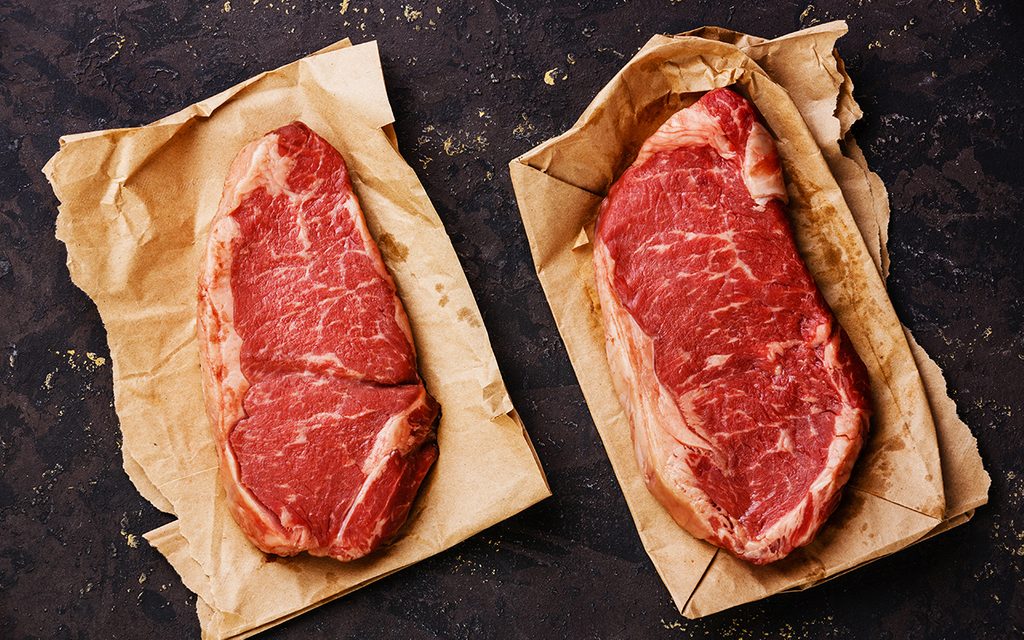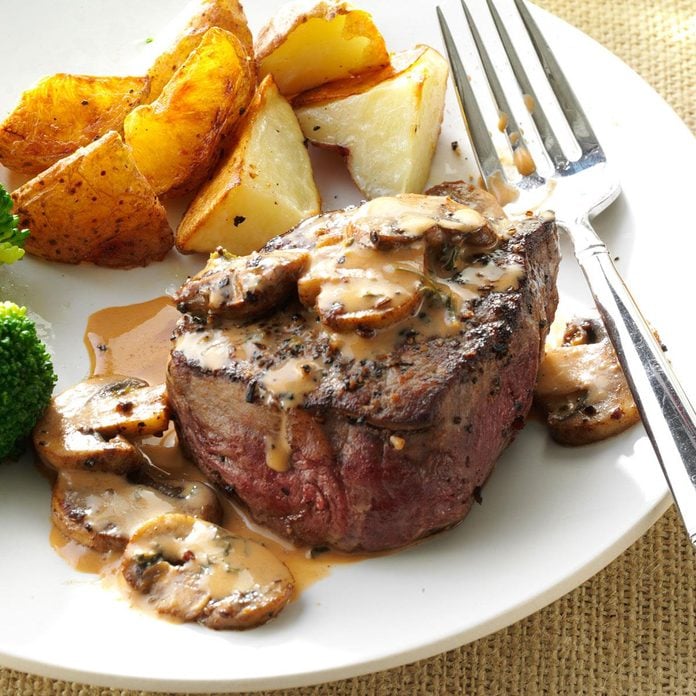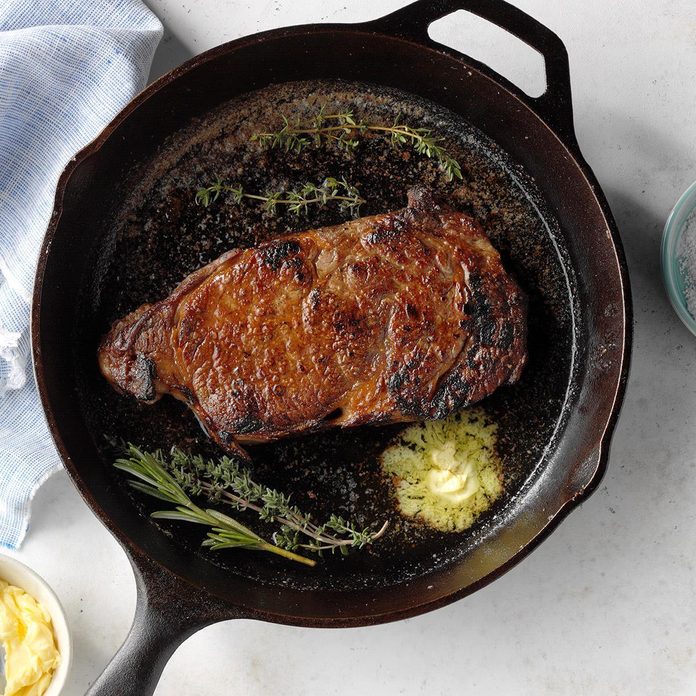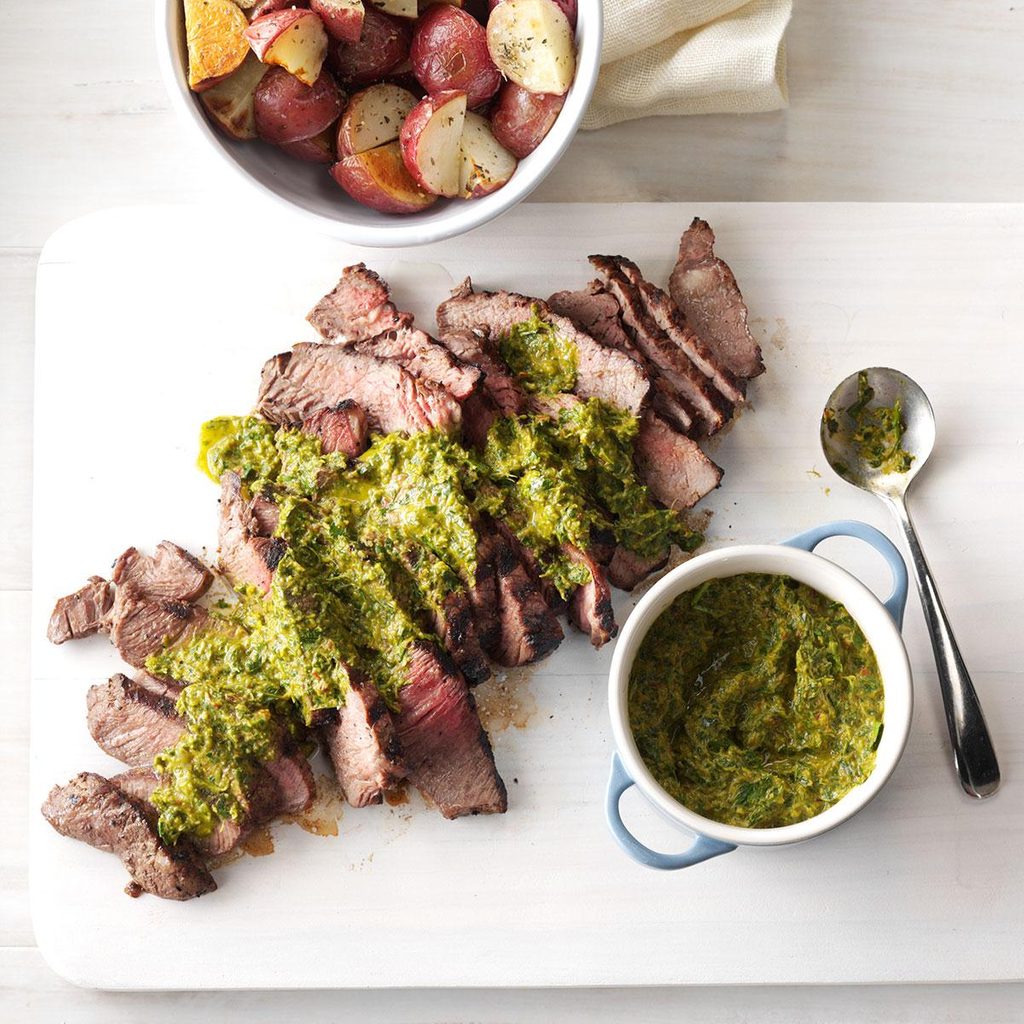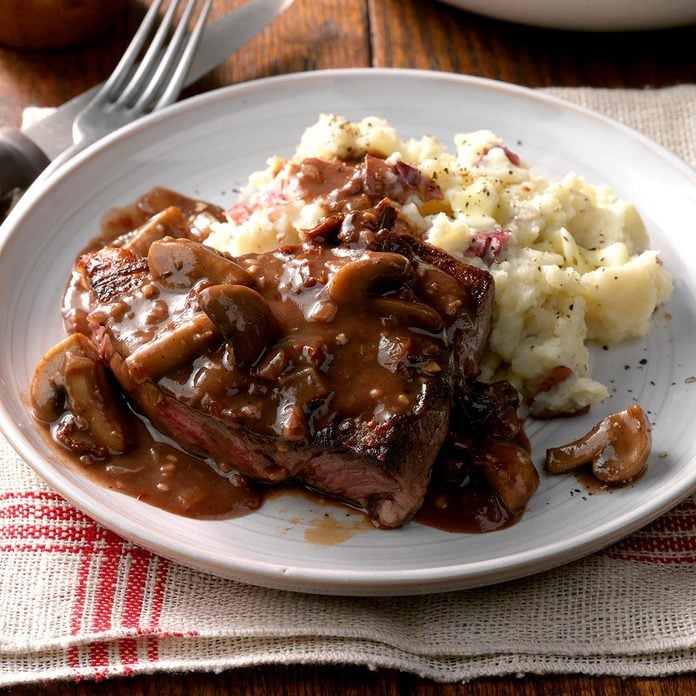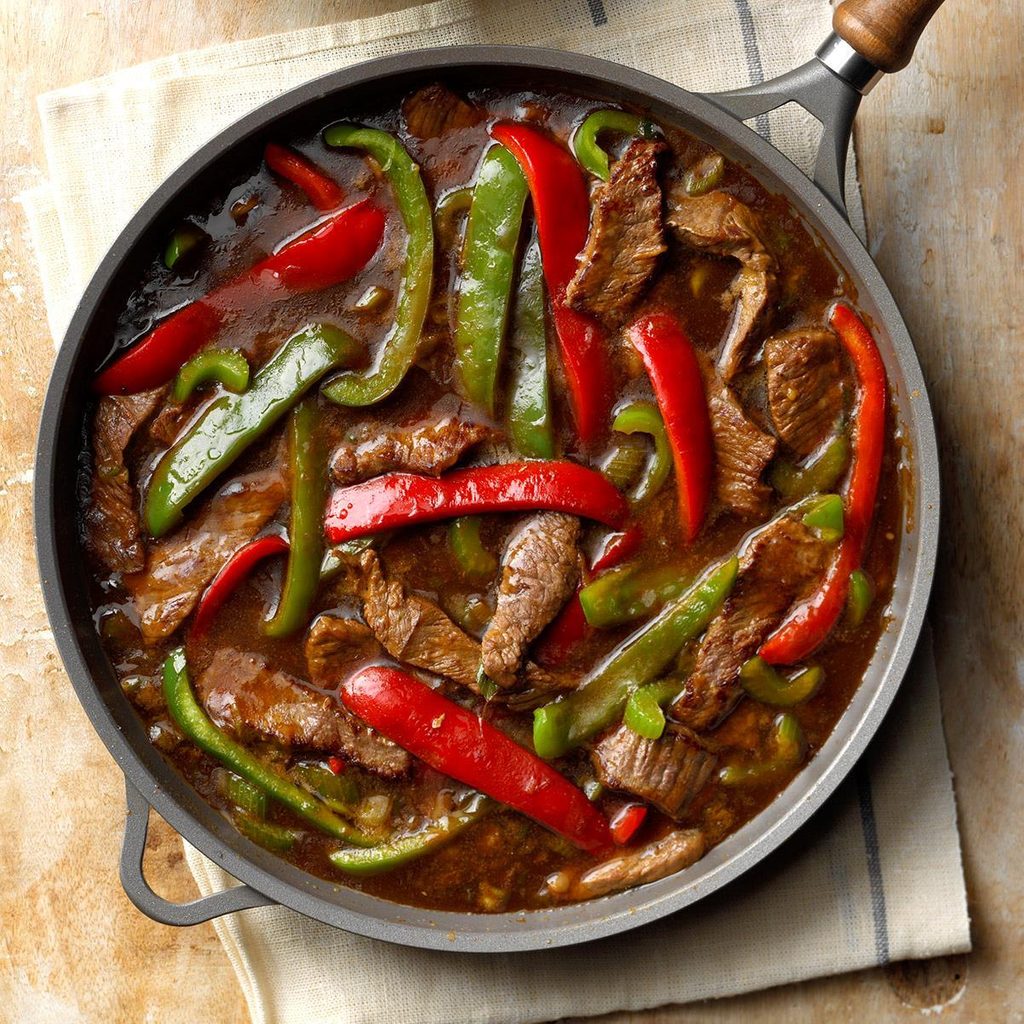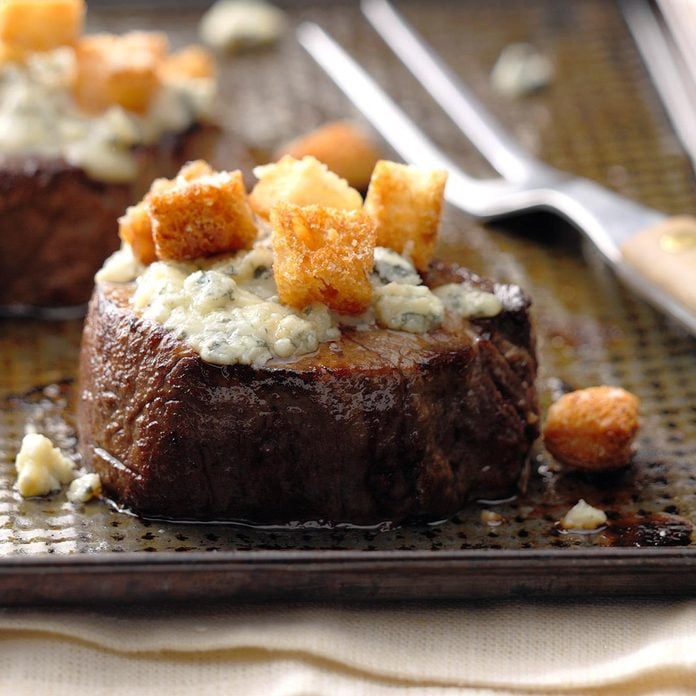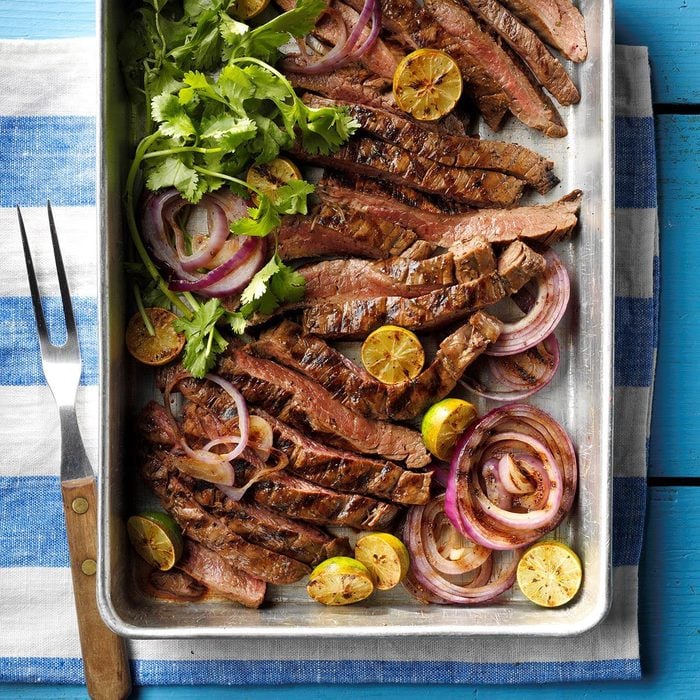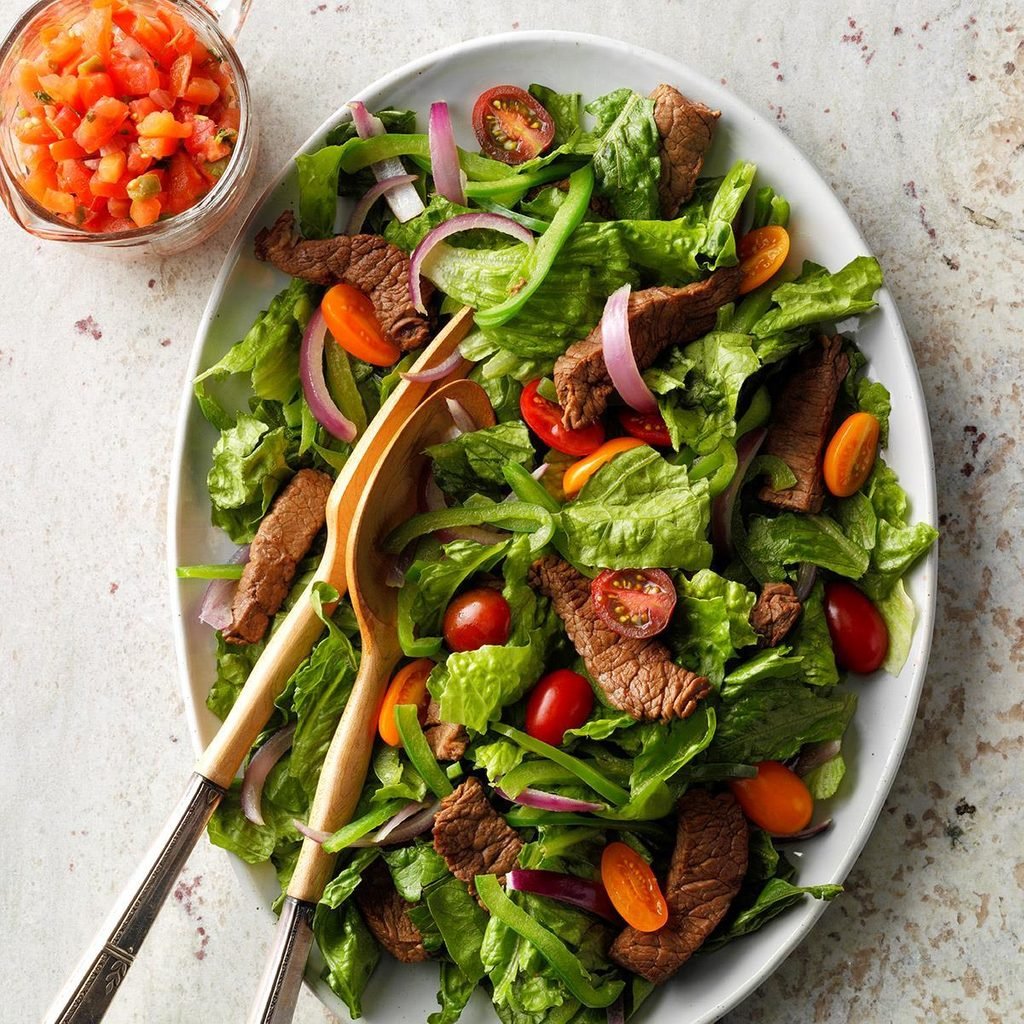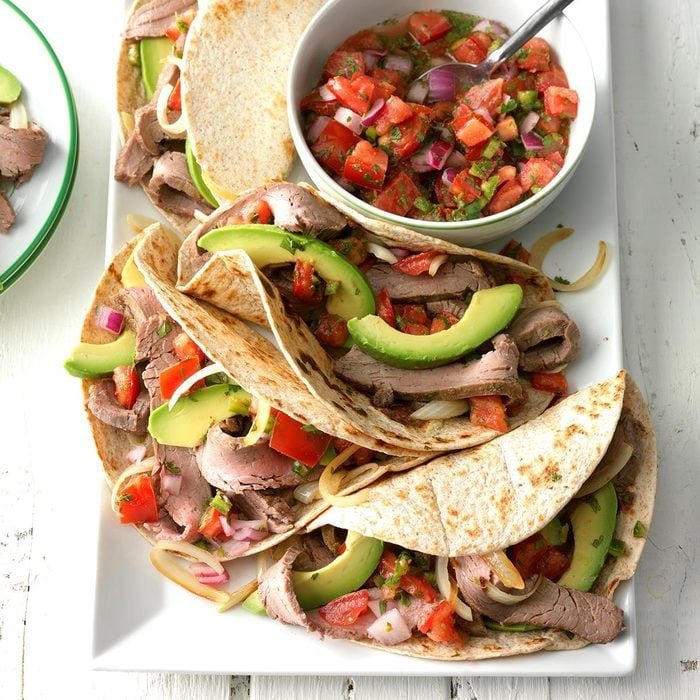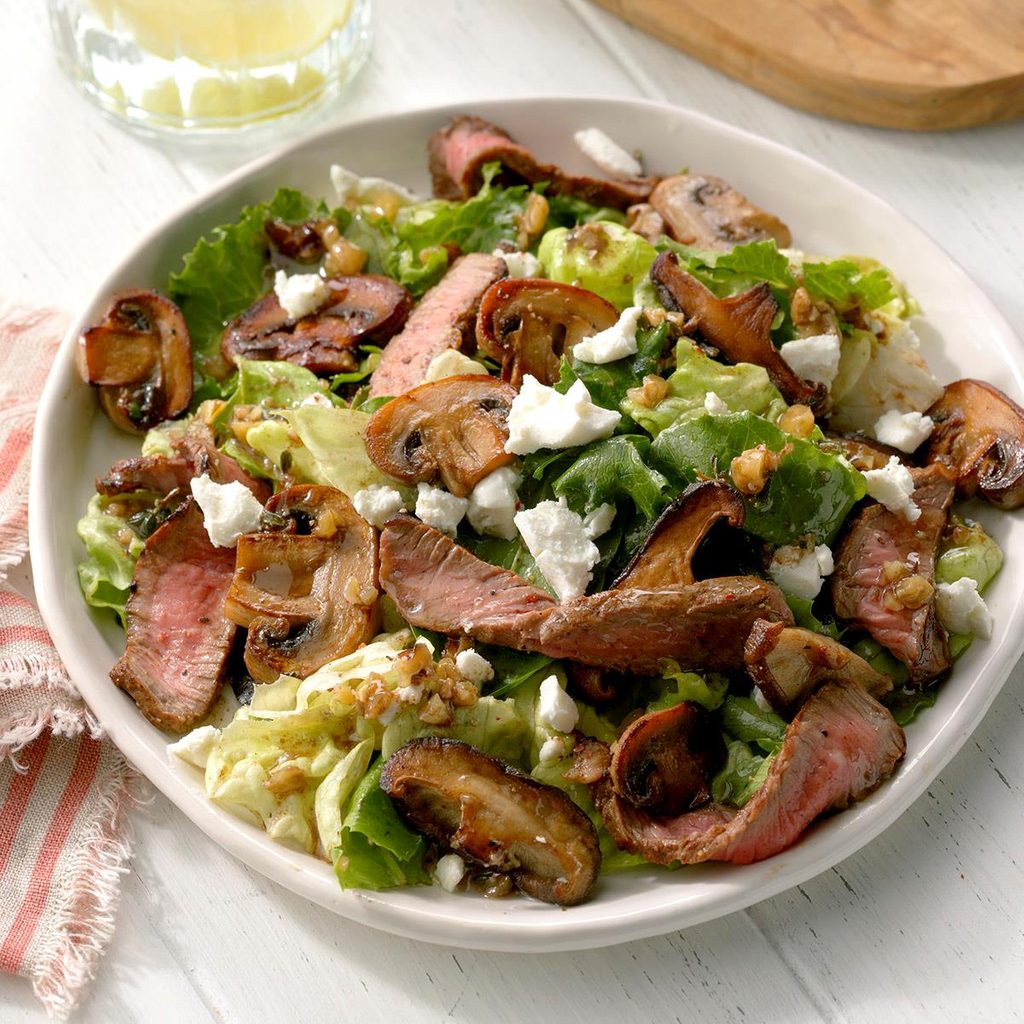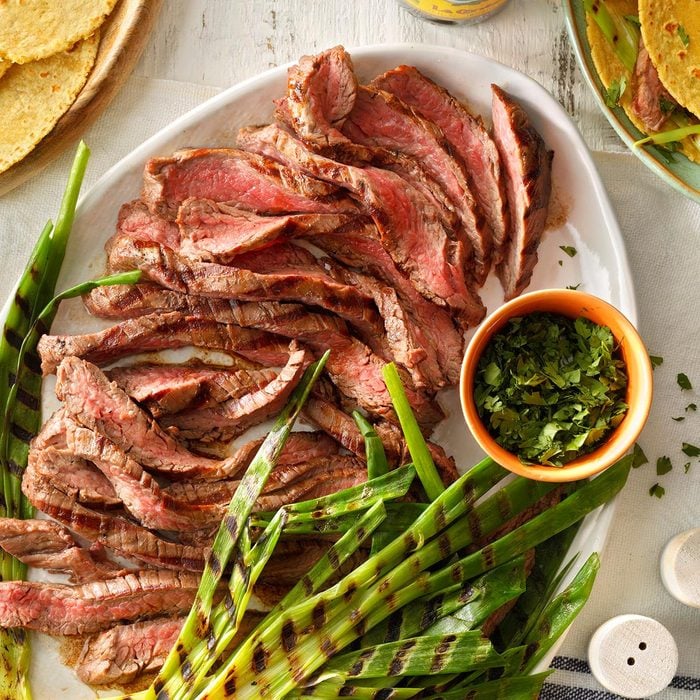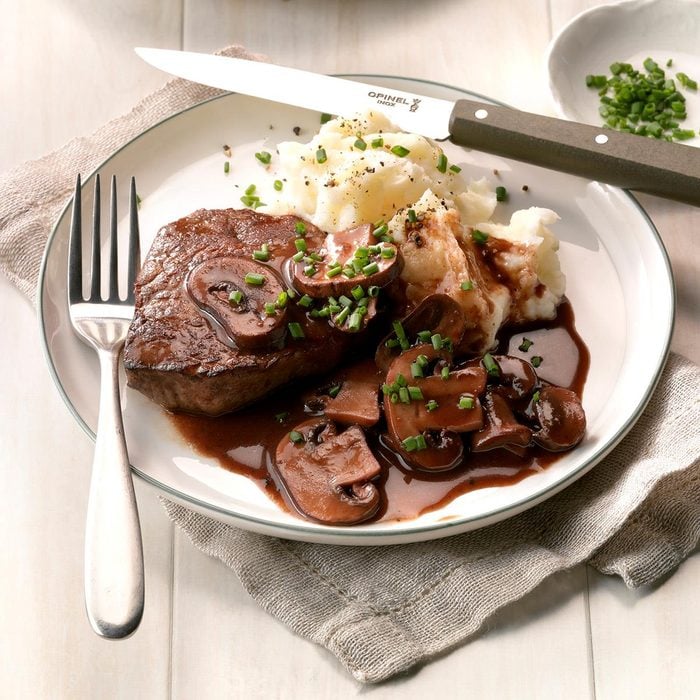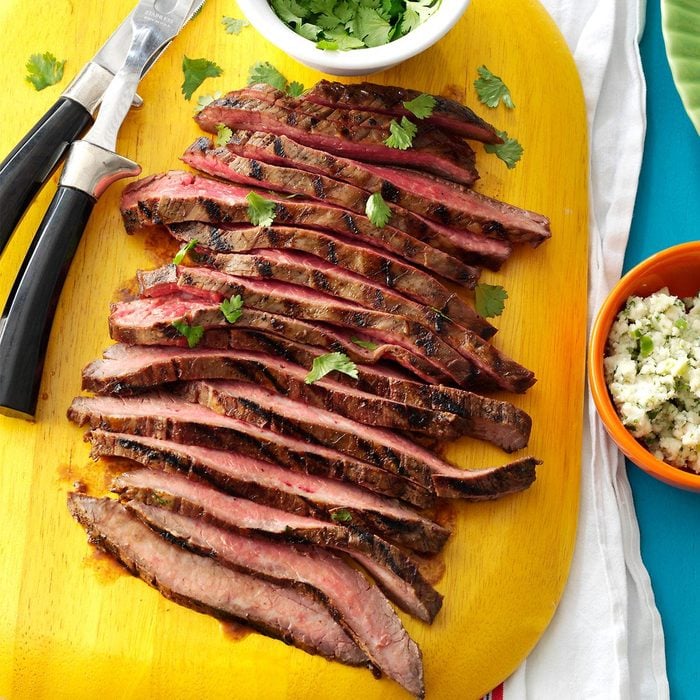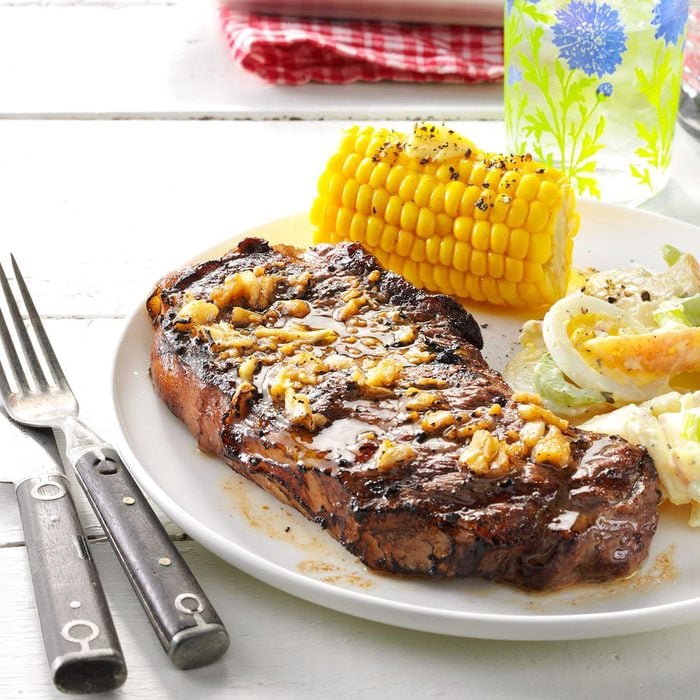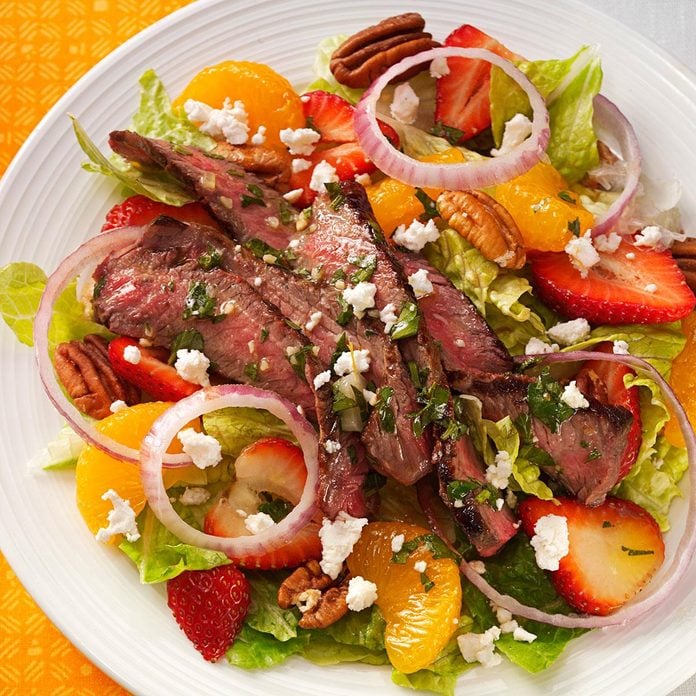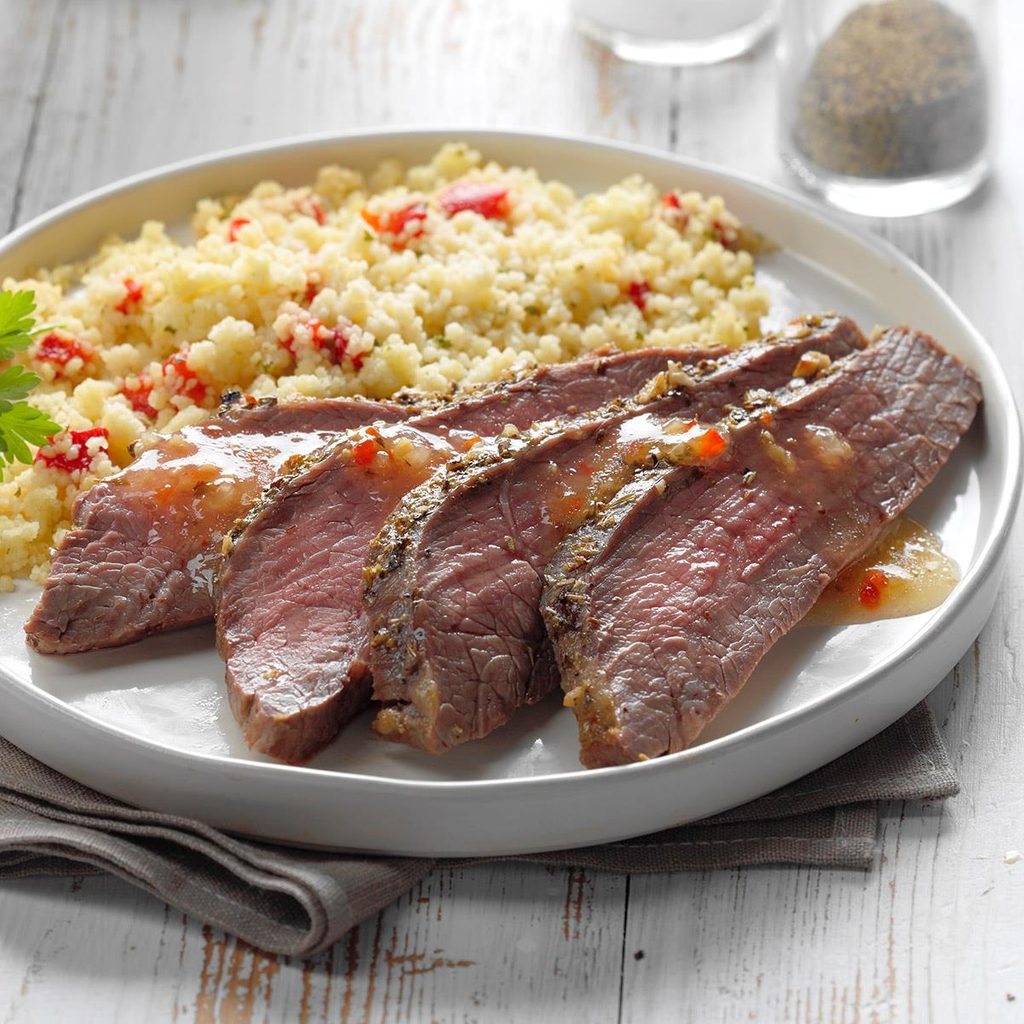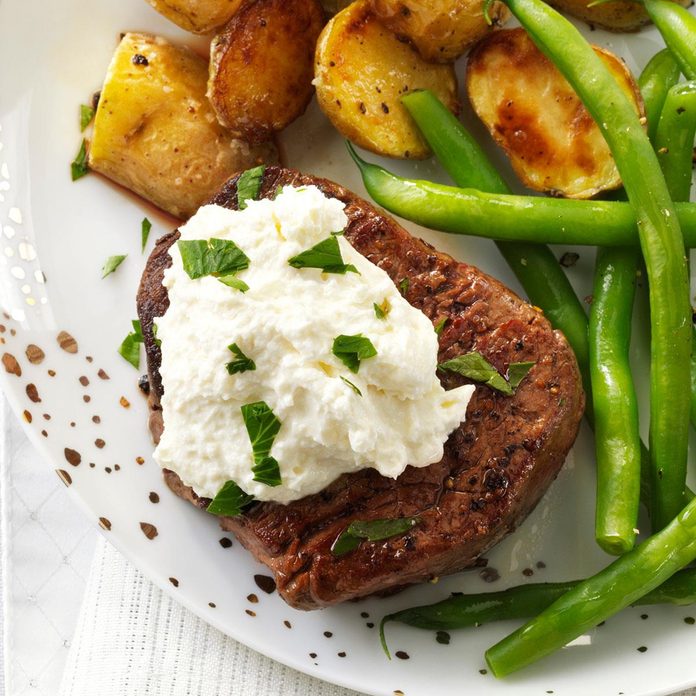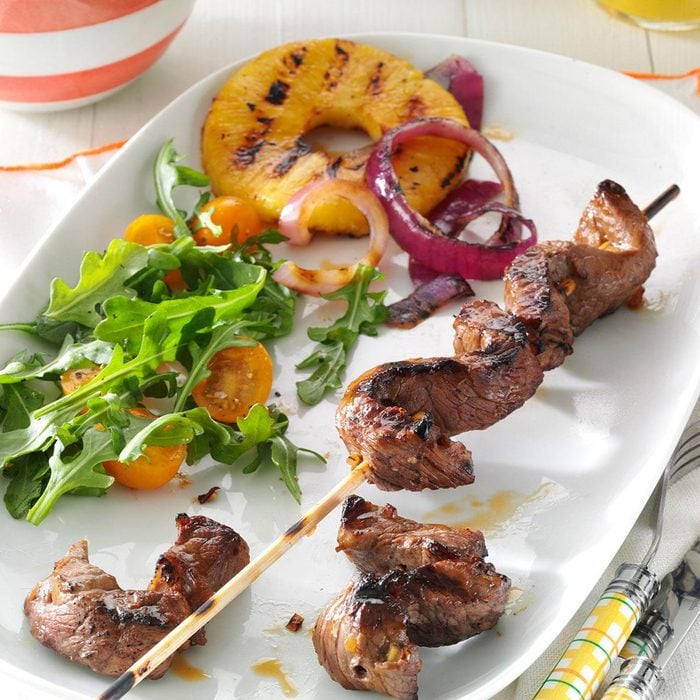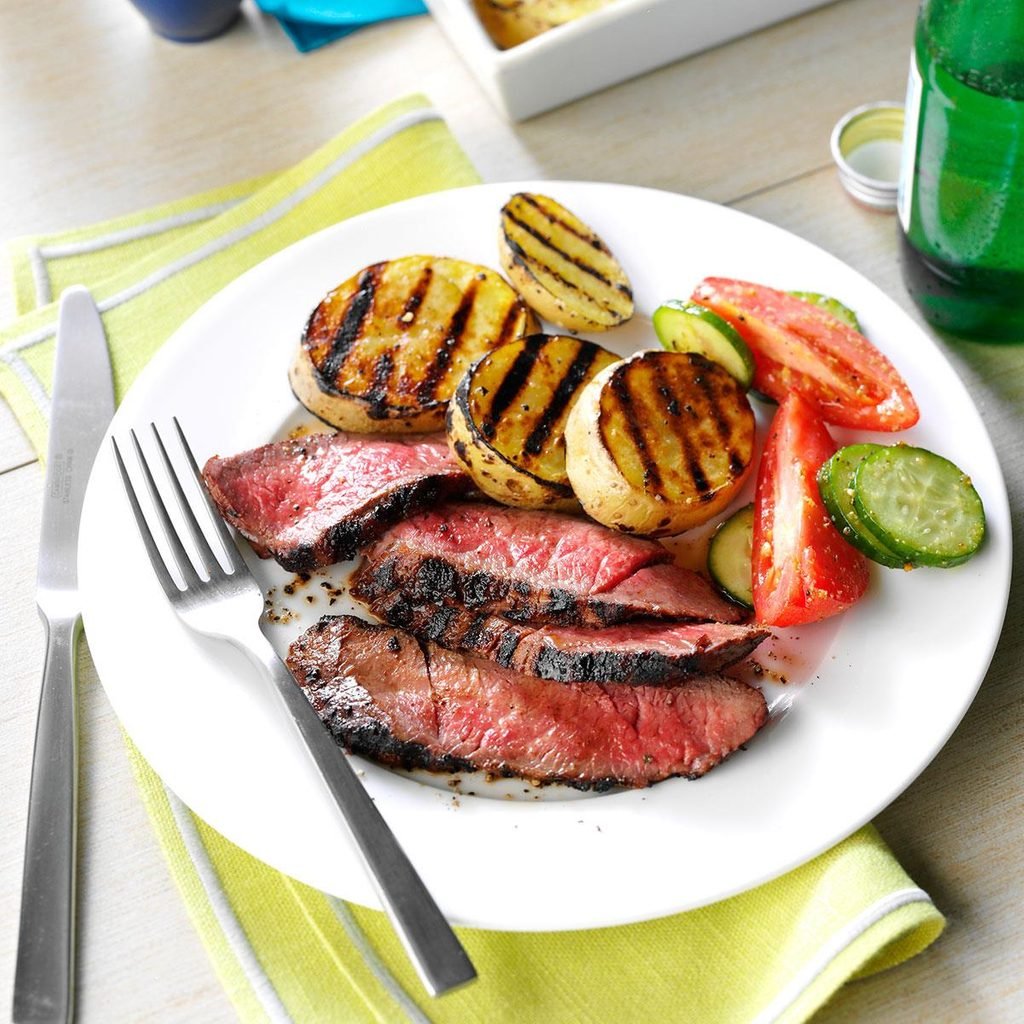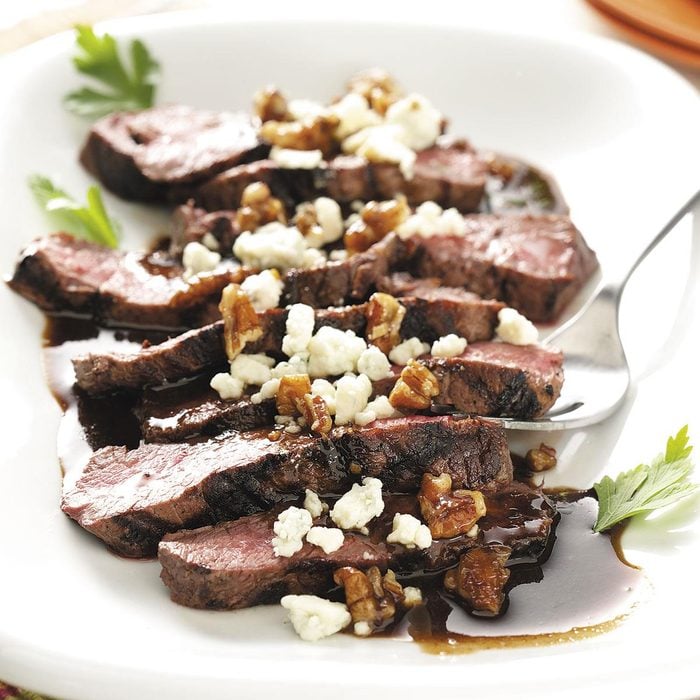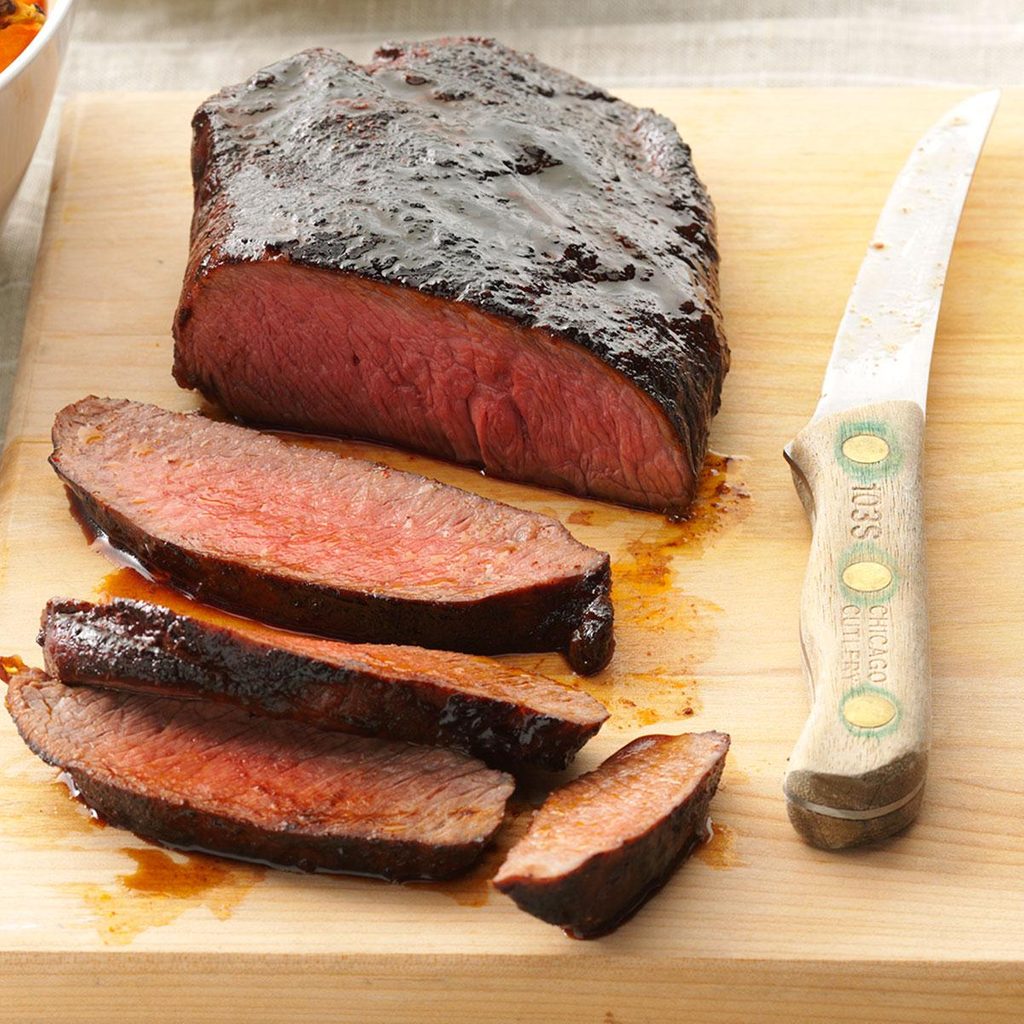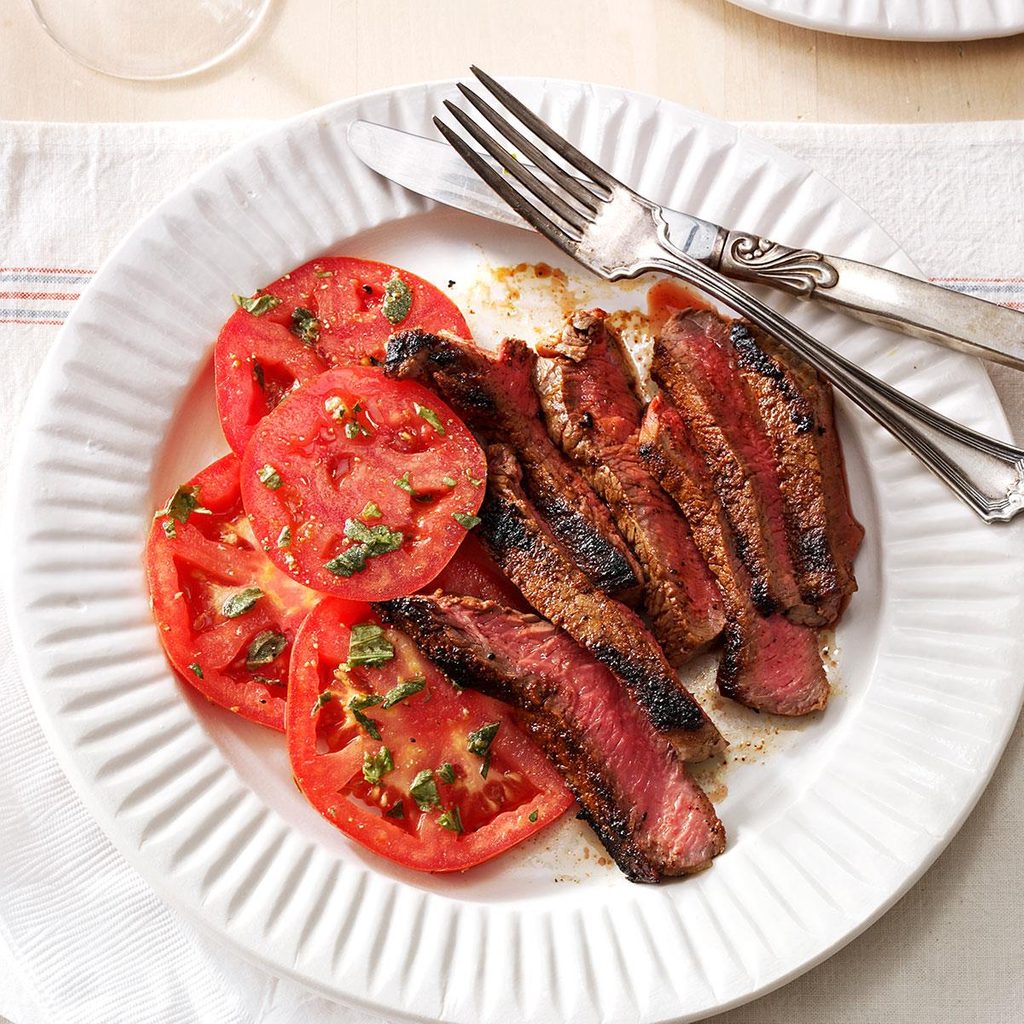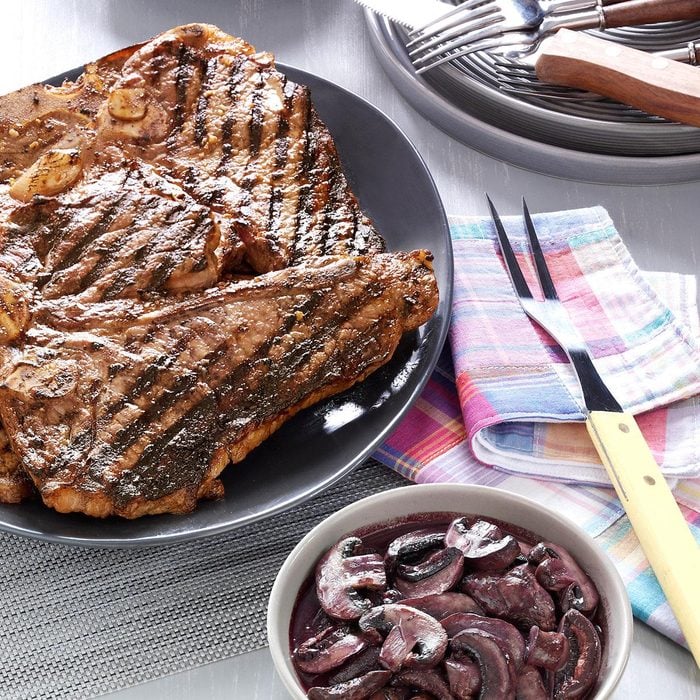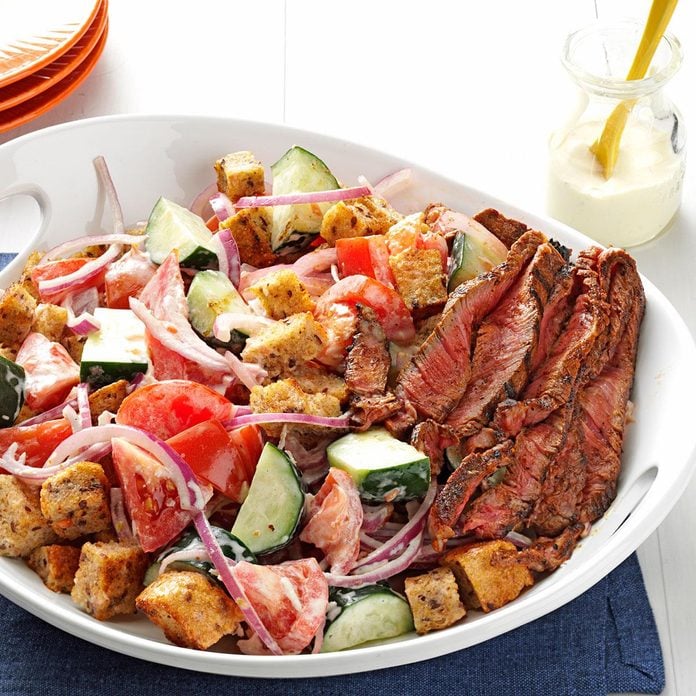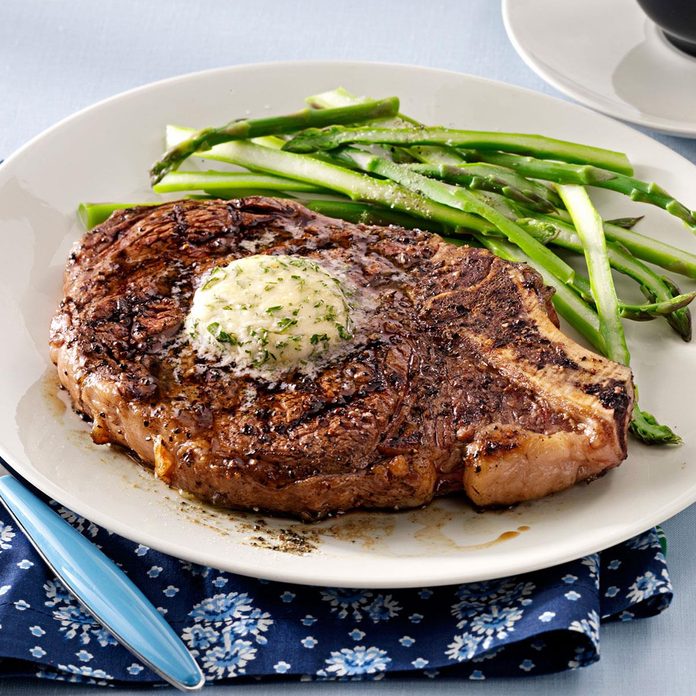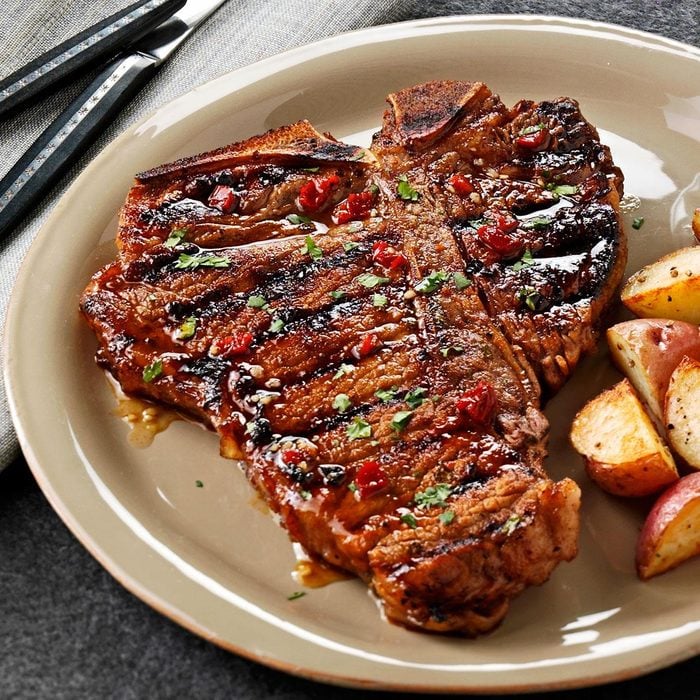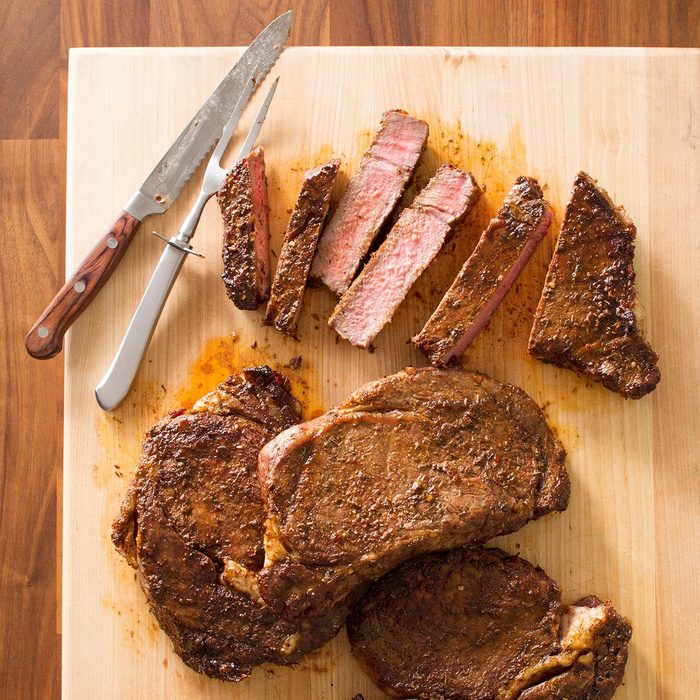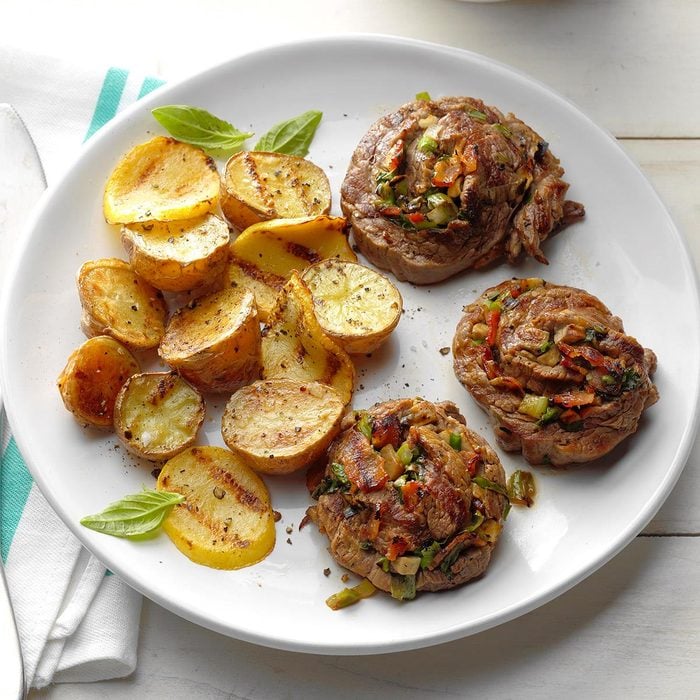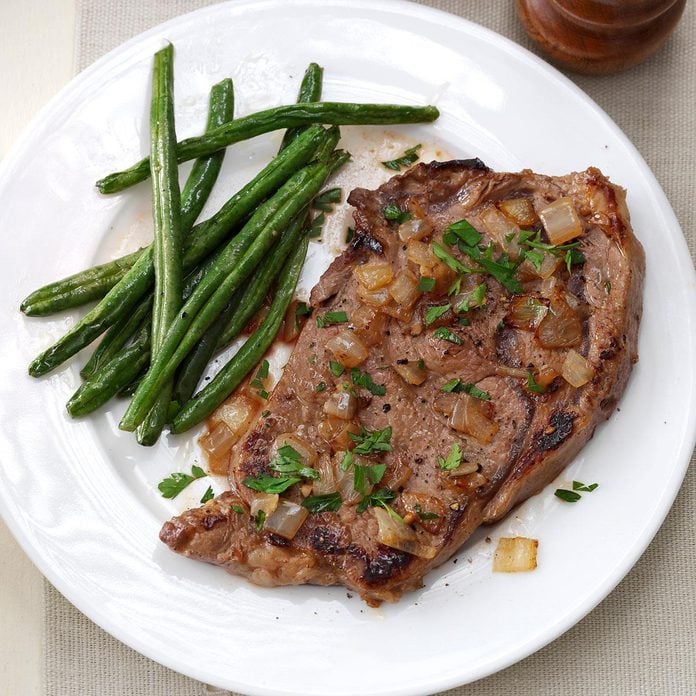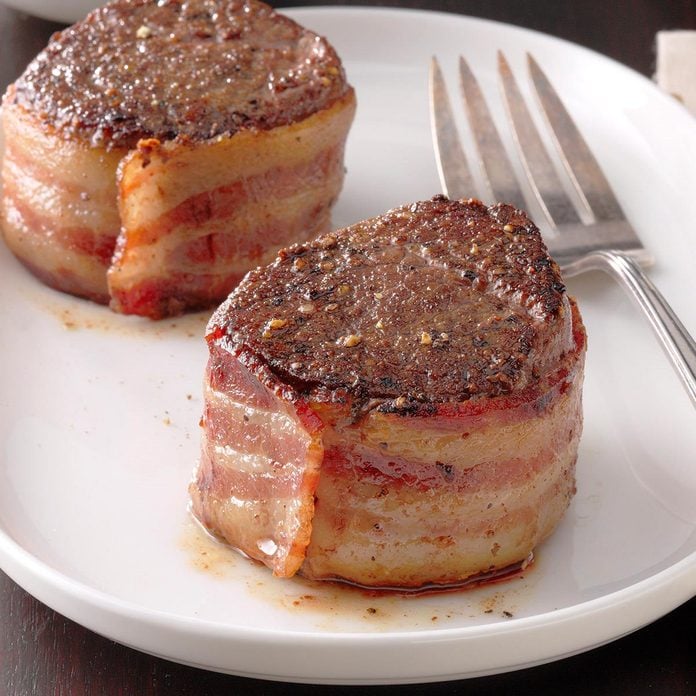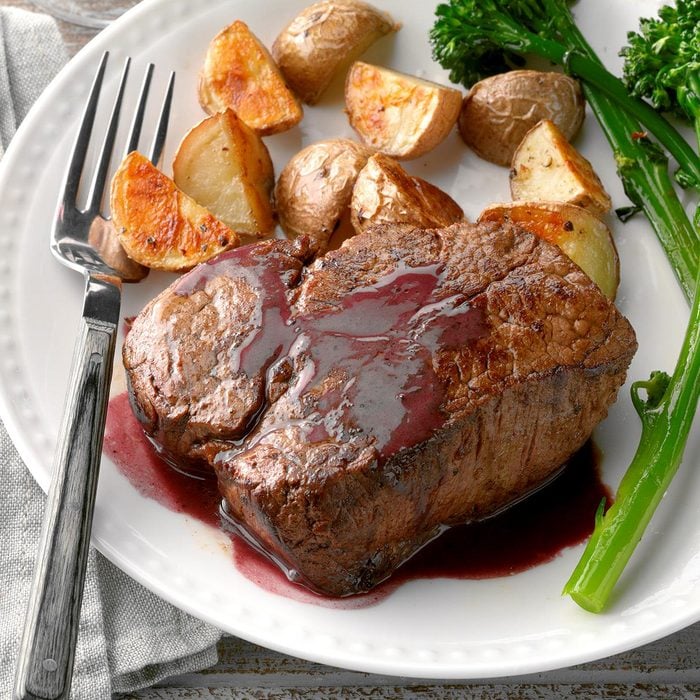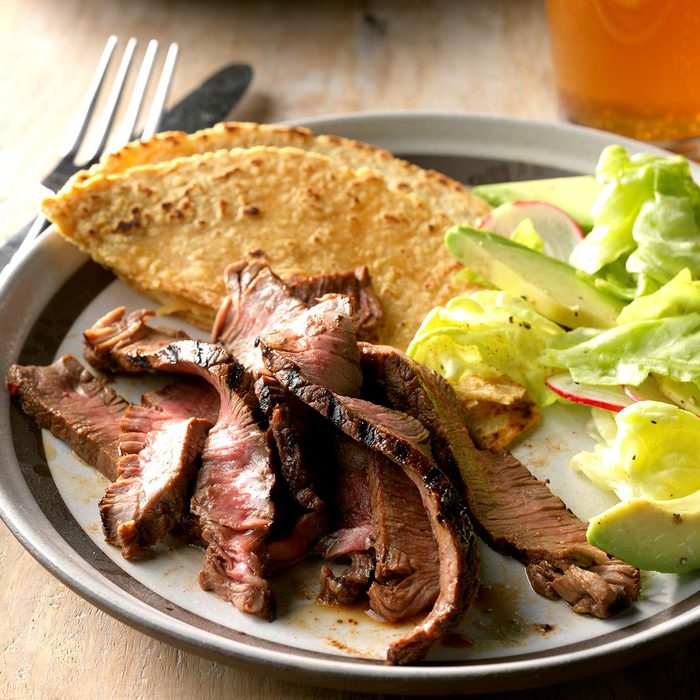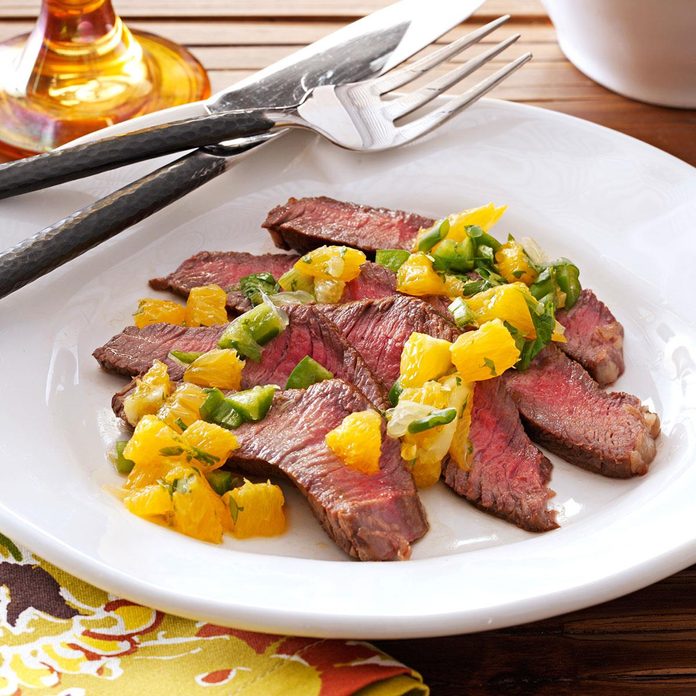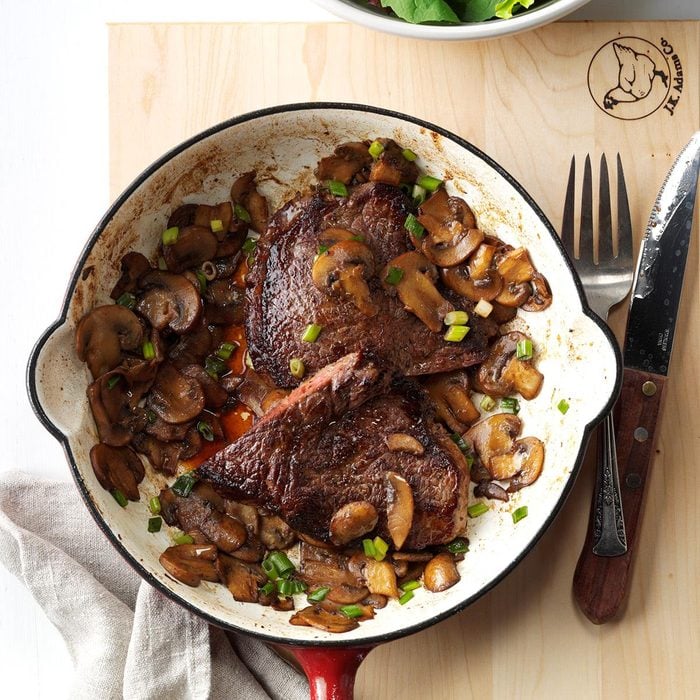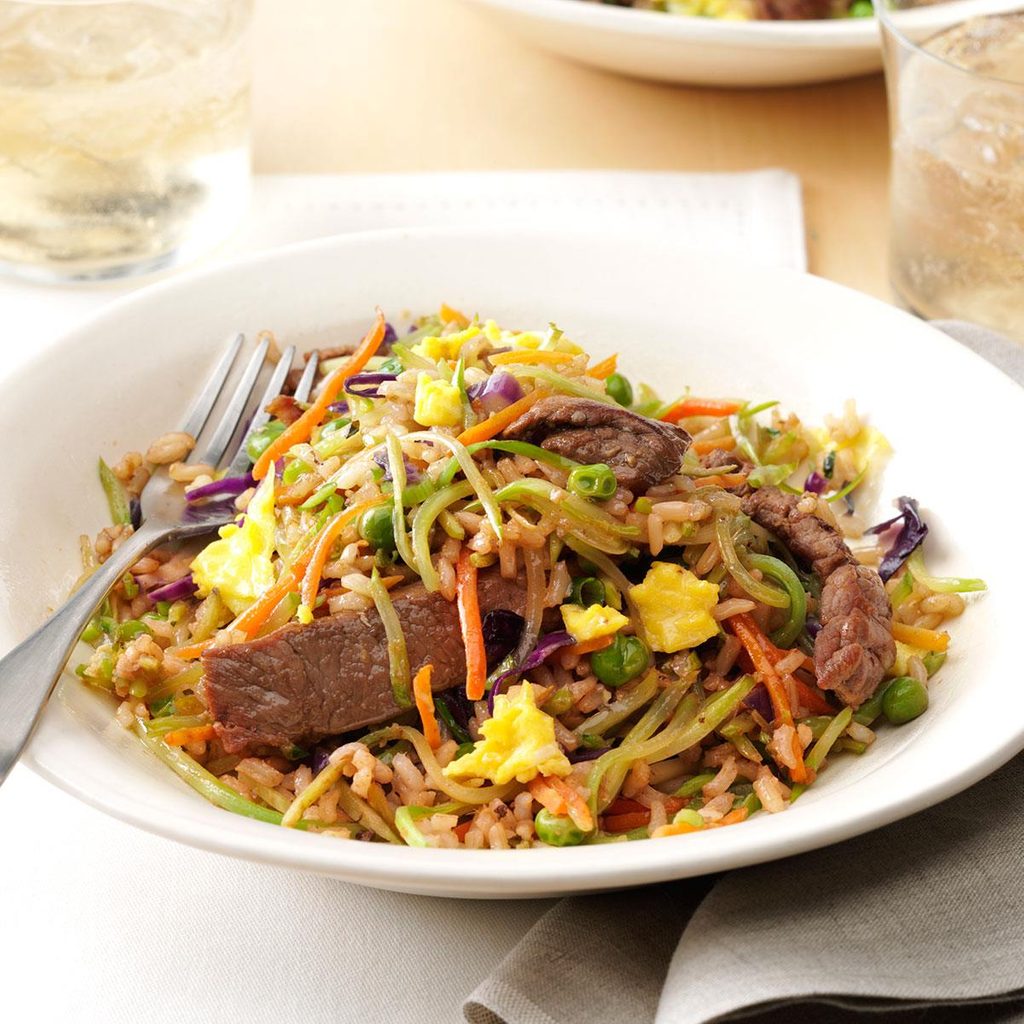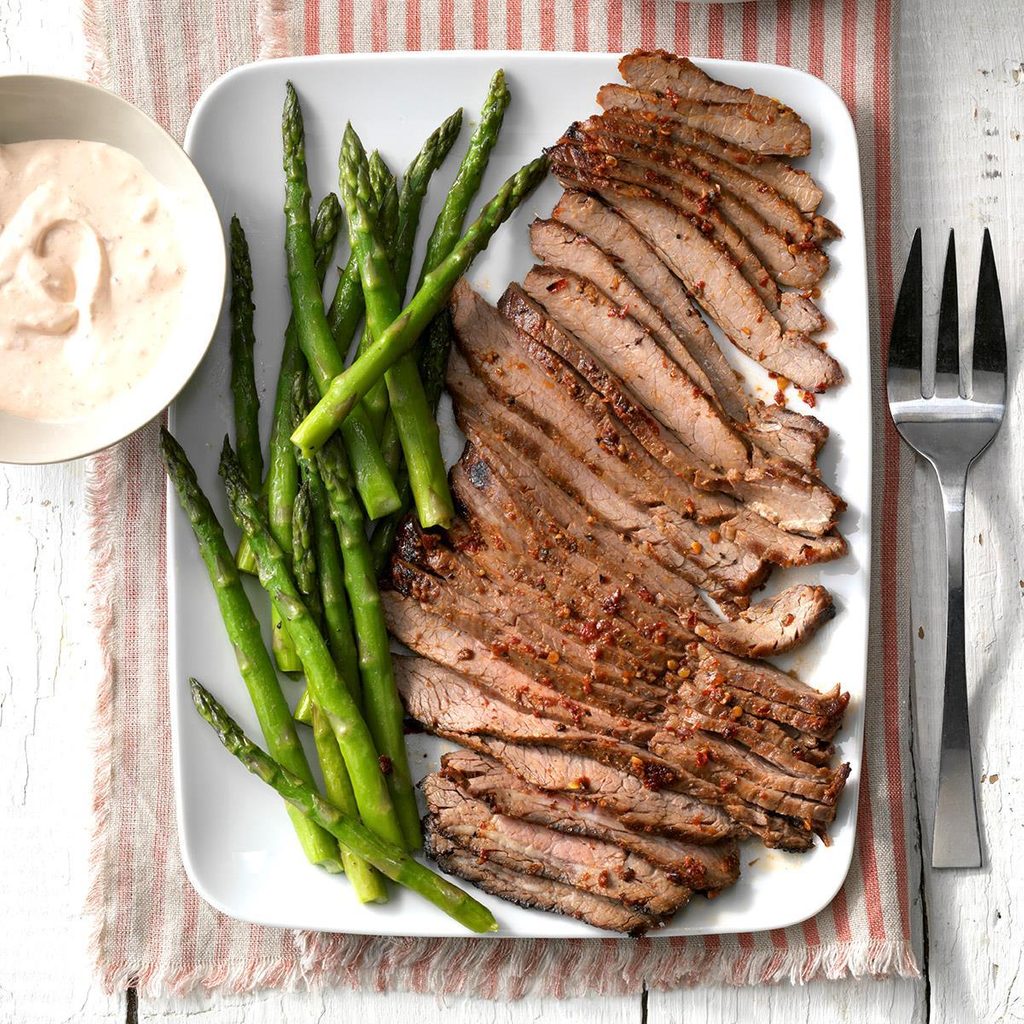There are a lot of things to consider when buying a steak: the USDA grade, bone-in or boneless, the name of the cut and the overall weight and thickness of the steak itself. It can be overwhelming!
As a former restaurant chef, I’ve spent a lot of time weighing price to value when it comes to steak. While I might serve a high-end steak like ribeye or filet mignon in a restaurant, that’s not necessarily the cut I choose when I’m cooking dinner.
What’s the best steak to buy for your budget? How do you navigate all those choices? Keep these insider tips in mind as you’re browsing the meat counter. Don’t be afraid to ask your butcher for suggestions, either; they know the best cuts of meat you should ask for.
Know the Meaning of Prime, Choice and Select
Most beef has a quality grade stamped on the package—Prime, Choice or Select. These ratings are chosen by the United States Department of Agriculture (USDA) based on a variety of factors, including the age of the cattle, the uniformity of the meat and the quantity of marbling.
In the end, the grade gives you a good idea of the overall tenderness, juiciness and flavor of a steak.
Prime cuts have the most marbling and they’re produced from young beef cattle. They’re also the most expensive and only account for about 2& of all beef graded by the USDA. If you have the money to spend, these steaks are the highest quality.
Next up are Choice cuts, which are still quality beef but they have less marbling than Prime steaks. Because they have less fat, they can become dry if they’re overcooked. Buying a Choice steak is my go-to option at home. So long as you avoid these common steak mistakes, Choice beef tastes fantastic and it doesn’t break the bank.
Finally, Select beef has the least amount of marbling, making it the leanest option. It can lack the juiciness of the higher grades, so you should marinate Select beef before cooking it. It’s not always best for dry heat cooking methods (like grilling or roasting), but it’s a great option for braised dishes.
If you don’t see any of these labels on your steak, it likely comes from ungraded beef. This is most common for ground beef, but you’ll also see it on store brand meat. It’s not necessarily bad, but you may want to give these steaks a good marinade, cook them low and slow and serve up a killer sauce, just in case.
Use All of Your Senses
If your cattle wasn’t processed in a USDA facility, it won’t have any of these gradings. You’ll have to rely on your eye and a butcher you trust to know what’s what. When you’re peering at rows of beef in the case, think like a chef:
- Color: Beef should have a bright, cherry red color. Gray beef isn’t necessarily bad, but it does mean that your meat was starved of oxygen in the display case. A rainbow-like or greenish sheen also don’t indicate decreased quality, but it happens when meat is exposed to too much light or heat during processing. Avoid steaks that are dark brown and look dry or crusty.
- Marbling: Fat is flavor, so a large amount of intramuscular fat is a sign your beef will taste great! Look for creamy white fat. If it has a yellowish tint, steer clear; it indicates the meat may be from an older animal.
- Aroma: Fresh beef shouldn’t have a strong aroma of any kind. It may smell slightly iron-forward, but like fish, it should smell clean. Any beef that smells sour or sweet is on its way to spoiling. In general, anytime you feel like something smells “off,” it’s better to be safe than sorry. Toss it and move on.
- Texture: You usually don’t get the chance to handle meat before your purchase, so it may be too late by the time you assess the texture. But, if your steak has a sticky feel or it’s slimy, it’s past its prime.
- Packaging: Look for packages without holes or tears, which can indicate improper handling or storage. You also want to avoid any packaging that has ballooned up with air or has excess liquid inside.
- Sell-By Date: When in doubt, always check the sell-by date. Beef is generally good for a day or two past this date, but it’s best not to push it—plan to sear up those steaks today.
Look for the Right Cut of Steak
This is a highly subjective topic, but it’s generally agreed that the tenderloin (or, filet mignon) is the most tender cut of steak. That being said, it’s not my personal favorite. Because it’s super lean, it can dry out if you’re not careful!
When you’re going all out, we recommend picking up a Prime ribeye or New York strip. They’re the easiest steaks to cook because of their high levels of marbling, which build in a lot of forgiveness in case you accidentally overcook them.
Any 1-inch-thick steaks cut from the short loin (like T-bone or porterhouse) or sirloin (top sirloin or tri-tip) are also fantastic choices for the grill when you’re on a budget. Thinner steaks from the plate (skirt or flank steak) tend to be tough but have a beefy flavor, and they grill up just fine if you marinate them.
I wouldn’t recommend grilling steaks that come from the chuck, briske, or round. These tougher cuts are inexpensive, but they’re better suited for low-and-slow cooking methods.
Next: Find the Best Way to Cook Your Steak
Tenderloin Steak DianeFor this classic skillet steak dinner, just sear the steaks in butter and top with a gorgeously silky mushroom cream sauce. It’s elegant and effortless all at once.
Cast-Iron Skillet SteakYou definitely don’t have to keep steak for special occasions. One of the easiest ways to cook it is seared in a cast-iron skillet with or without butter. All you need after that is a nice
leafy salad to complete the meal.
Psst! If you love steak, you need this
custom branding iron for grilled meats.
Steak with Chipotle-Lime ChimichurriChimichurri is a piquant herb sauce that complements steak perfectly. Once you learn how to make the sauce, you'll want to serve it all summer long.
Steaks with Mushroom SauceBy using top sirloin, this dish is great for a weeknight dinner for two or four. The rich mushroom-wine sauce brings out the best of the beef-forward flavor, and it tastes great with sides like roasted potatoes and green beans.
Quick Pepper SteakWith a simple sweet and savory sauce, sliced sirloin and fresh bell peppers, this skillet supper comes together in a flash. Serve it with steamed white, brown or cauliflower rice for a fuller meal.
Beef Steaks with Blue CheeseBroil, grill or quickly sear these steaks in a cast-iron pan to get a nice caramelized crust on the outside while keeping the meat tender inside. The size of the steaks, blue cheese topping and croutons can easily be cut in half for smaller portion sizes.
Flank Steak PinwheelsButterfly and flatten a flank steak so there’s a large surface area for this savory red pepper and spinach stuffing. Roll it up, wrap in bacon (yes!) and grill for a few minutes. Once sliced, serve with a delicious creamy blue cheese sauce.
Key West Flank SteakFlank steak is great for the grill, especially with this lime and garlic marinade, and it cooks quickly, just a few minutes per side. After letting it rest, slice against the grain. Need more ideas for this economical cut of beef? Check out some of our other
flank steak recipes.
Zesty Steak SaladCook marinated top sirloin steak for this zesty salad, or feel free to use leftover steak from another meal. While the base is leafy romaine lettuce, add anything else you love to the bowl, from cucumbers and mushrooms to cheese.
Air-Fryer Steak FajitasOf course you can make steak in the air fryer! This marinated flank steak takes less than 10 minutes. While you let it rest, slice avocado, onion and lime wedges for serving.
Mushroom Steak Salad with Walnut VinaigretteThis steak salad is a great date night steak recipe because it’s impressive but easy to throw together for any night of the week. Serve with some crusty bread and a great bottle of wine.
Grilled Onion & Skirt Steak TacosSkirt steak is usually a pretty tough cut with lots of connective tissue. That’s why you want to use something like this beer and lime marinade to tenderize it and add flavor. Like other
grilled steak recipes, a quick sear over the fire is all it takes.
Beef Filets with Portobello SauceThese steaks with a rich and savory portobello mushroom sauce are a perfect meal for two. Complete the meal with zesty potatoes, a leafy salad and a hunk of great bread.
Flank Steak with Cilantro & Blue Cheese ButterOnce you learn a great
steak marinade recipe, you’ll be able to turn even the toughest cut of meat into a delicious dinner. This sweet citrus marinade transforms flank steak into a tender flavorful cut.
Garlic Grilled SteaksElevate your grilled strip or ribeye steaks with this amazing garlic mixture. Have extra? Learn how to repurpose last night’s dinner into one of these amazing
leftover steak recipes.
Citrus Steak SaladThere are so many wonderful flavors in this salad, thanks to fresh greens, mandarin oranges, strawberries and a citrusy vinaigrette. The only thing you need to cook is the steak, and dinner is on the table in no time.
Flank Steak with CouscousFor this recipe, use sirloin steak if you prefer it over flank steak. Both take only minutes to broil and have lots of beefy flavor. Make sure to cut against the grain for the most tender pieces.
Tenderloin with Horseradish Cream CheeseThe sharp peppery flavor of horseradish has always been a great foil for a rich, juicy steak. Blend it with cream cheese, parmesan and parsley for a delicious steak topper, and serve with a classic baked potato.
Teriyaki Steak SkewersThese teriyaki steak skewers will be the hit of your next backyard barbecue. The aroma alone will get everyone’s attention, but once they taste the sweet and savory marinade, they’ll be hooked. You can easily double or triple this recipe for a crowd.
Southwest Steak & PotatoesMake this whole meal on the grill for your next cookout. The steak gets a brush of vinegar and Worcestershire before a rub of zesty spices, and the potatoes taste great with a little char from the fire.
Maple & Blue Cheese SteakA marinade of balsamic vinegar, maple syrup and Dijon adds a ton of flavor to this steak, and it complements the sharp blue cheese topping. Any cut that you’d grill works here, including sirloin, strip or ribeye.
Smoky Espresso SteakWith espresso, cocoa and pumpkin pie spice, it may sound like you’re making dessert, but it’s actually a delicious rub that transforms broiled or grilled flat iron steak into a flavor bomb.
Grilled Steaks with Marinated TomatoesTalk about peak summer. Sometimes all you need for a perfectly grilled steak is a side of fresh garden tomatoes marinated in raspberry vinaigrette and fresh herbs and spices. A side of cheesy potatoes or sauteed green beans work, too!
Garlic-Rubbed T-Bones with Burgundy MushroomsPorterhouse or T-bone steaks are great on the grill, especially when rubbed with garlic and served with wine-soaked mushrooms. Take dinner to another level with
creamy twice-baked potatoes and a Caesar salad.
Chili-Rubbed Steak & Bread SaladThe chili-rubbed grilled steak and fresh vegetables make this panzanella-like salad a one-bowl meal. Use thick-cut bread for the cubes so they can soak up all the flavors.
Grilled Ribeyes with Herb ButterWith Dijon and herbs de Provence, this full-flavored marinade practically takes you to the French countryside. After the steaks come off the grill, top with a savory herb butter. For something more American, try our new obsession:
cowboy butter.
Chipotle-Honey Grilled T-BonesFor all the heat lovers out there, these T-bones have a spicy kick. Great on the grill or seared indoors, make these the centerpiece of a Tex Mex-inspired dinner.
Peppered Ribeye SteaksThis peppery DIY steak rub brings out all the beefy flavor of grilled ribeye steaks. Pair it with a
sweet corn and tomato salad for a perfect summer meal.
Grilled Steak PinwheelsEasy to prepare, steak pinwheels make a statement, especially with this savory mushroom filling. It’s a great summertime option when the grill (and the days and nights) are hot and you want to keep the kitchen cool.
Saucy Skillet SteaksButter, Dijon and onion turns an everyday steak dinner into something special. Ribeyes are the choice cut for this steak recipe, but you can do the same with a NY strip or tenderloin; the sauce is even great on chicken or burgers.
Bacon-Wrapped Filets with Scotched MushroomsYou’ve seen the bacon-wrapped filet mignon at the grocery store, but it’s just as easy to make at home. This recipe is perfect for two (yay, date night!), but it can easily be doubled or tripled for a dinner party.
Merlot Filet MignonRemember: when you’re cooking with wine, don’t use the cheap stuff; cook with one you’d like to drink. It makes all the difference in a buttery wine sauce like this.
Chocolate-Chipotle Sirloin SteakCocoa powder won’t make your steak sweet. Unsweetened chocolate adds depth and color to steak. It’s also a perfect complement to smoky chipotle peppers. Here are some other surprising
ingredients that take your steak from good to great.
Steak with Citrus SalsaIn the summer, this lime marinade perks up grilled steaks. In the winter, broiled or pan-seared steaks get a blast of sunshine from citrus salsa.
Skillet Steak SupperBecause everything for this quick and easy meal is cooked in one skillet, prep work and cleanup is a breeze. The delicious wine and mushroom sauce will have everyone thinking you spent hours in the kitchen, though.
Ginger Steak Fried RiceTurn leftover rice and steak into a quick fried rice. Broccoli slaw mix and frozen peas make it an easy-peasy weeknight meal.
Spicy Flank SteakSpice up a flank steak with red pepper flakes and chili powder, and then serve with a cool sour cream sauce. If you prefer, grill the steak over medium-high heat rather than broiling.
